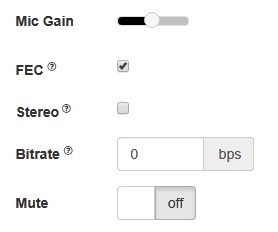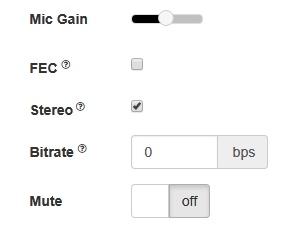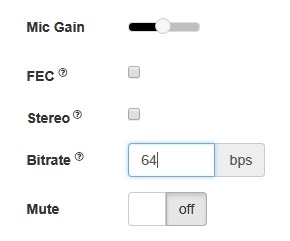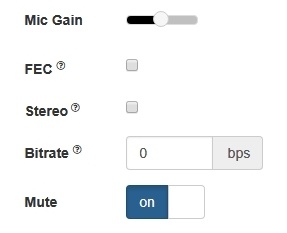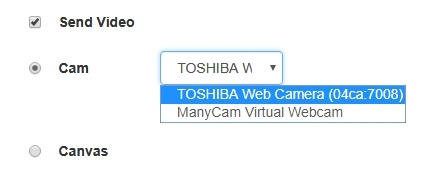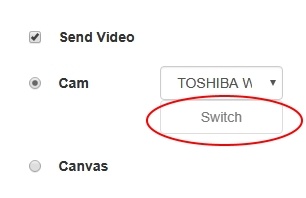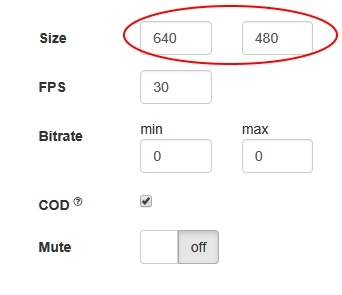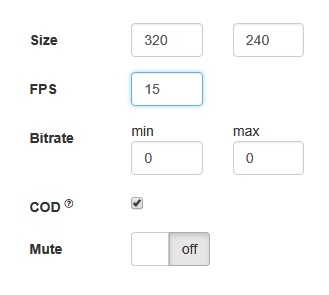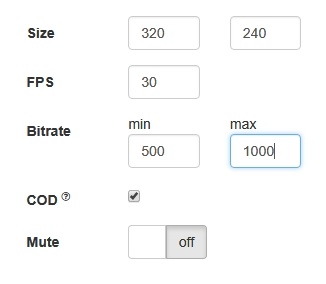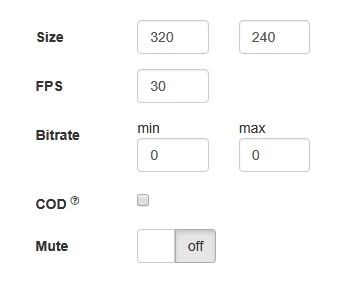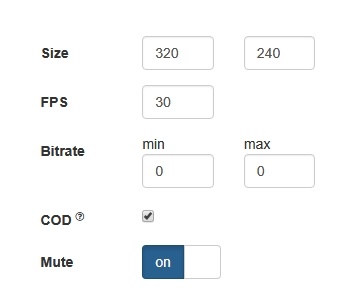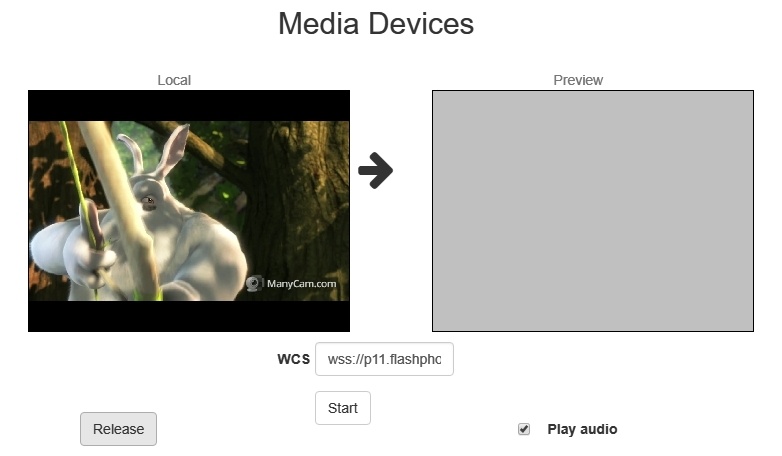WCS allows configuring the camera and the microphone from a browser. Let's see how this can be done and what parameters you can adjust when an audio and video stream is captured. We use the Media Devices web application as an example:
Microphone settings
1. Selecting the microphone from the list
code:
Flashphoner.getMediaDevices(null, true).then(function (list) {
list.audio.forEach(function (device) {
var audio = document.getElementById("audioInput");
var i;
var deviceInList = false;
for (i = 0; i < audio.options.length; i++) {
if (audio.options[i].value == device.id) {
deviceInList = true;
break;
}
}
if (!deviceInList) {
var option = document.createElement("option");
option.text = device.label || device.id;
option.value = device.id;
audio.appendChild(option);
}
});
...
}).catch(function (error) {
$("#notifyFlash").text("Failed to get media devices");
});
2. Adjusting microphone gain (works in Chrome only)
code:
$("#micGainControl").slider({
range: "min",
min: 0,
max: 100,
value: currentGainValue,
step: 10,
animate: true,
slide: function (event, ui) {
currentGainValue = ui.value;
if(previewStream) {
publishStream.setMicrophoneGain(currentGainValue);
}
}
});
3. Enabling error correction (for the Opus codec only)
code:
if (constraints.audio) {
constraints.audio = {
deviceId: $('#audioInput').val()
};
if ($("#fec").is(':checked'))
constraints.audio.fec = $("#fec").is(':checked');
...
}
4. Setting stereo/mono mode.
code:
if (constraints.audio) {
constraints.audio = {
deviceId: $('#audioInput').val()
};
...
if ($("#sendStereoAudio").is(':checked'))
constraints.audio.stereo = $("#sendStereoAudio").is(':checked');
...
}
5. Setting audio bitrate in kbps
code:
if (constraints.audio) {
constraints.audio = {
deviceId: $('#audioInput').val()
};
...
if (parseInt($('#sendAudioBitrate').val()) > 0)
constraints.audio.bitrate = parseInt($('#sendAudioBitrate').val());
}
6. Turning off the microphone (mute).
code:
if ($("#muteAudioToggle").is(":checked")) {
muteAudio();
}
Camera settings
1. Camera selection
code:
Flashphoner.getMediaDevices(null, true).then(function (list) {
...
list.video.forEach(function (device) {
...
});
}).catch(function (error) {
$("#notifyFlash").text("Failed to get media devices");
});
2. Switching cameras.
code:
$("#switchBtn").text("Switch").off('click').click(function () {
publishStream.switchCam();
}).prop('disabled', $('#sendCanvasStream').is(':checked'));
Switching of the camera can be done "on the fly" during stream broadcasting. Here is how switching works:
- On PC cameras switch in the order they are defined in the device manager of the operating system.
- On Android, if Chrome is used, the default is the frontal camera. If Firefox is used, the default is the rear camera.
- On iOS in the Safari browser, by default the frontal camera is selected, but in the drop-down the rear camera is the first.
3. Specifying the resolution of the video
code:
function resizeLocalVideo(event) {
var requested = constraints.video;
if (requested.width != event.target.videoWidth || requested.height != event.target.videoHeight) {
console.warn("Camera does not support requested resolution, actual resolution is " + event.target.videoWidth + "x" + event.target.videoHeight);
}
$("#publishResolution").text(event.target.videoWidth + "x" + event.target.videoHeight);
resizeVideo(event.target);
}
4. Setting FPS
code:
if (constraints.video) {
if (constraints.customStream) {
...
} else {
...
if (parseInt($('#fps').val()) > 0)
constraints.video.frameRate = parseInt($('#fps').val());
}
}
5.Setting video bitrate in kbps
code:
if (constraints.video) {
if (constraints.customStream) {
...
} else {
...
if (parseInt($('#sendVideoMinBitrate').val()) > 0)
constraints.video.minBitrate = parseInt($('#sendVideoMinBitrate').val());
if (parseInt($('#sendVideoMaxBitrate').val()) > 0)
constraints.video.maxBitrate = parseInt($('#sendVideoMaxBitrate').val());
...
}
}
6. Setting CPU Overuse Detection
code:
if (!$("#cpuOveruseDetection").is(':checked')) {
mediaConnectionConstraints = {
"mandatory": {
googCpuOveruseDetection: false
}
}
}
7. Turning off the camera (mute)
code:
if ($("#muteVideoToggle").is(":checked")) {
muteVideo();
}
Testing camera and microhpone capturing locally
Local camera and microphone test is intended to check capturing in browser without publishing stream to server.
code:
function startTest() {
if (Browser.isSafariWebRTC()) {
Flashphoner.playFirstVideo(localVideo, true);
Flashphoner.playFirstVideo(remoteVideo, false);
}
Flashphoner.getMediaAccess(getConstraints(), localVideo).then(function (disp) {
$("#testBtn").text("Release").off('click').click(function () {
$(this).prop('disabled', true);
stopTest();
}).prop('disabled', false);
window.AudioContext = window.AudioContext || window.webkitAudioContext;
if (Flashphoner.getMediaProviders()[0] == "WebRTC" && window.AudioContext) {
for (i = 0; i < localVideo.children.length; i++) {
if (localVideo.children[i] && localVideo.children[i].id.indexOf("-LOCAL_CACHED_VIDEO") != -1) {
var stream = localVideo.children[i].srcObject;
audioContextForTest = new AudioContext();
var microphone = audioContextForTest.createMediaStreamSource(stream);
var javascriptNode = audioContextForTest.createScriptProcessor(1024, 1, 1);
microphone.connect(javascriptNode);
javascriptNode.connect(audioContextForTest.destination);
javascriptNode.onaudioprocess = function (event) {
...
}
}
}
} else if (Flashphoner.getMediaProviders()[0] == "Flash") {
micLevelInterval = setInterval(function () {
$("#micLevel").text(disp.children[0].getMicrophoneLevel());
}, 500);
}
testStarted = true;
}).catch(function (error) {
$("#testBtn").prop('disabled', false);
testStarted = false;
});
drawSquare();
}
SDP parameters replacing
When publishing stream, there is a possibility to replace SDP parameters. In 'SDP replace' field string template is set for search for the parameter to replace, and in 'with' field new parameter value is set.
To replace SDP parameters, a callback function is used that should be set on stream creation in sdpHook option of createStream() method:
stream creation code
previewStream = session.createStream({
name: streamName,
display: remoteVideo,
constraints: constraints,
sdpHook: rewriteSdp
...
})
rewriteSdp function code
function rewriteSdp(sdp) {
var sdpStringFind = $("#sdpStringFind").val();
var sdpStringReplace = $("#sdpStringReplace").val();
if (sdpStringFind != 0 && sdpStringReplace != 0) {
var newSDP = sdp.sdpString.toString();
newSDP = newSDP.replace(sdpStringFind, sdpStringReplace);
return newSDP;
}
return sdp.sdpString;
}
Rising up the bitrate of video stream published in Chrome browser
SDP parameters replacement allows to rise video streeam published bitrate. To do this, SDP parameter 'a' must be replaced by this template:
a=fmtp:(.*) (.*)
to
a=fmtp:$1 $2;x-google-min-bitrate=2500
where 2500 is the bitrate in kilobytes per second.
Similarly, video bitrate on start can be set (x-google-start-bitrate attribute) and maximum bitrate can be limited (x-google-max-bitrate attribute)
Note that this feature is available in Chrome browser only.
Setting up codecs
When publishing the stream, there is a possibility to eliminate from WebRTC SDP codecs that should not be used to publish the given stream, for example:
publishStream = session.createStream({
...
stripCodecs: ["h264", "flv", "mpv"]
}).on(STREAM_STATUS.PUBLISHING, function (publishStream) {
...
});
publishStream.publish();
Such a capability is handy when you need to find some workaround for bugs of a browser or if it conflicts with the given codec. For example, if H.264 does not work in a browser, you can turn it off and switch to VP8 when working via WebRTC.

